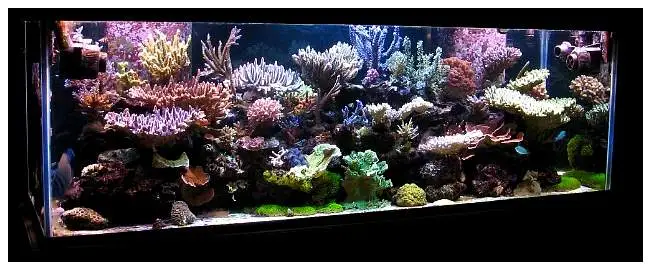Stunning 180-Gallon Reef Tank by John Tangeman | ReefKeeping

Tank Specifications
Volume: 180 Gallons / 681 Liters
Dimensions (L × W × H):
0.0" ×
0.0" ×
0.0"
0.0cm ×
0.0cm ×
0.0cm
Equipment List
- Salt: Unknown
Frequently Asked Questions
How do I set up a reef tank with a bare bottom?
To set up a reef tank without substrate, start by preparing a stable base for your tank. Use a dense marine stabilized plastic board (like Starboard) on the bottom for protection and easy cleaning. Arrange your live rock in a way that enhances water flow and supports coral growth without blocking circulation.
What kind of flow rate do I need for SPS corals?
For SPS corals, it's important to maintain a high flow rate. Aim for several thousand gallons per hour; you can achieve this by using multiple powerheads and pumps. Devices like Tunze powerheads provide adjustable flow patterns, and using eductors can enhance flow by increasing water movement and reducing dead spots.
How do I keep my water parameters stable?
Regular testing and adjustments are key to maintaining stable water parameters. Use reliable tests for calcium, alkalinity, nitrate, phosphate, specific gravity, temperature, and pH. Consider using a calcium reactor for calcium and alkalinity; regular water changes (about 15 gallons weekly) will help keep nutrient levels in check.
What type of skimmer is best for a bare bottom reef tank?
For a bare bottom reef tank, a good skimmer is crucial. A DIY needle-wheel skimmer can be effective, especially one that is tall and driven by powerful pumps, such as Sedra 5000s. This allows for efficient removal of organic material before it can break down.
How often should I change the carbon in my sump?
Changing the carbon in your sump regularly (every 2-4 weeks) is advisable. This helps maintain water clarity and reduces unwanted substances in the water. Monitor your tank's clarity and odor to determine the right frequency for your setup.
What lighting setup is best for SPS corals?
For SPS corals, a combination of metal halide and VHO lighting works well. Use multiple 250-watt metal halide bulbs along with VHO actinic lights for a balanced spectrum. Position higher light-requiring corals near the center and lower light corals at the edges for optimal growth.
How do I create a dawn/dusk effect in my reef tank?
To create a dawn/dusk effect, use timers to stagger the lighting. Start with dim actinic bulbs turning on before increasing the intensity with metal halide bulbs. This gradual change mimics natural sunlight and helps reduce stress on your corals.
How do I feed my fish without harming the corals?
It's advisable to feed your fish high-quality pellets and nori while ensuring that excess food is quickly skimmer up. Using an autofeeder can help distribute food while preventing accumulation that might harm corals. Monitor feeding closely to control nutrients while promoting coral health.
What role does fish waste play in coral health?
Fish waste can be beneficial for coral growth, as it provides nutrients that feed the corals directly or stimulate bacterial growth which enhances nutrient cycling. A balanced diet for fish is essential for maintaining a clean and productive reef environment.